2011 CHEVROLET HHR ECU
[x] Cancel search: ECUPage 29 of 430
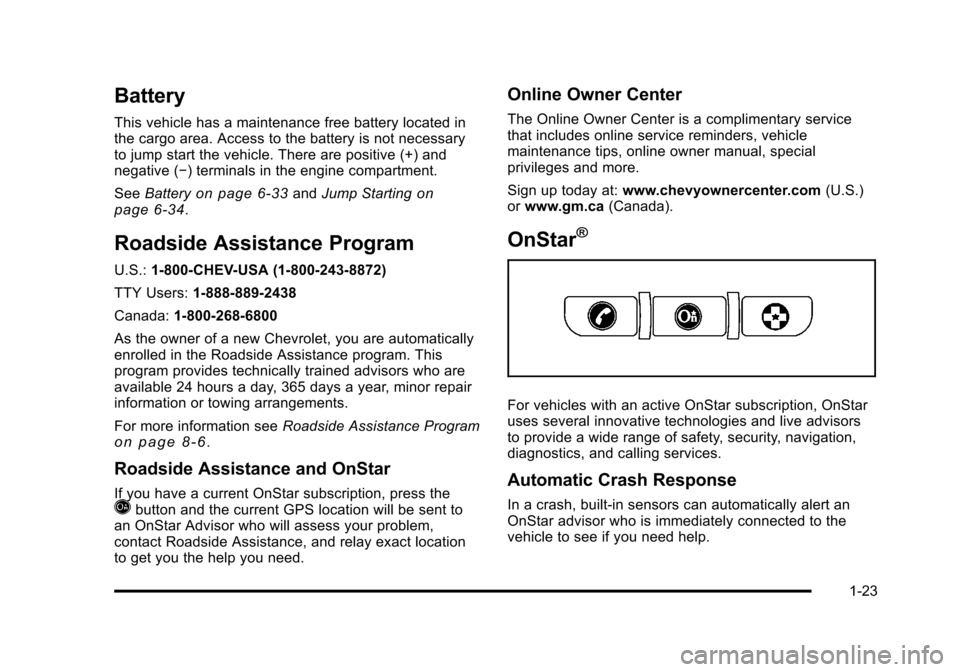
Black plate (23,1)Chevrolet HHR Owner Manual - 2011
Battery
This vehicle has a maintenance free battery located in
the cargo area. Access to the battery is not necessary
to jump start the vehicle. There are positive (+) and
negative (−) terminals in the engine compartment.
SeeBattery
on page 6‑33andJump Startingon
page 6‑34.
Roadside Assistance Program
U.S.: 1-800-CHEV-USA (1-800-243-8872)
TTY Users: 1-888-889-2438
Canada: 1-800-268-6800
As the owner of a new Chevrolet, you are automatically
enrolled in the Roadside Assistance program. This
program provides technically trained advisors who are
available 24 hours a day, 365 days a year, minor repair
information or towing arrangements.
For more information see Roadside Assistance Program
on page 8‑6.
Roadside Assistance and OnStar
If you have a current OnStar subscription, press theQbutton and the current GPS location will be sent to
an OnStar Advisor who will assess your problem,
contact Roadside Assistance, and relay exact location
to get you the help you need.
Online Owner Center
The Online Owner Center is a complimentary service
that includes online service reminders, vehicle
maintenance tips, online owner manual, special
privileges and more.
Sign up today at: www.chevyownercenter.com (U.S.)
or www.gm.ca (Canada).
OnStar®
For vehicles with an active OnStar subscription, OnStar
uses several innovative technologies and live advisors
to provide a wide range of safety, security, navigation,
diagnostics, and calling services.
Automatic Crash Response
In a crash, built‐in sensors can automatically alert an
OnStar advisor who is immediately connected to the
vehicle to see if you need help.
1-23
Page 33 of 430
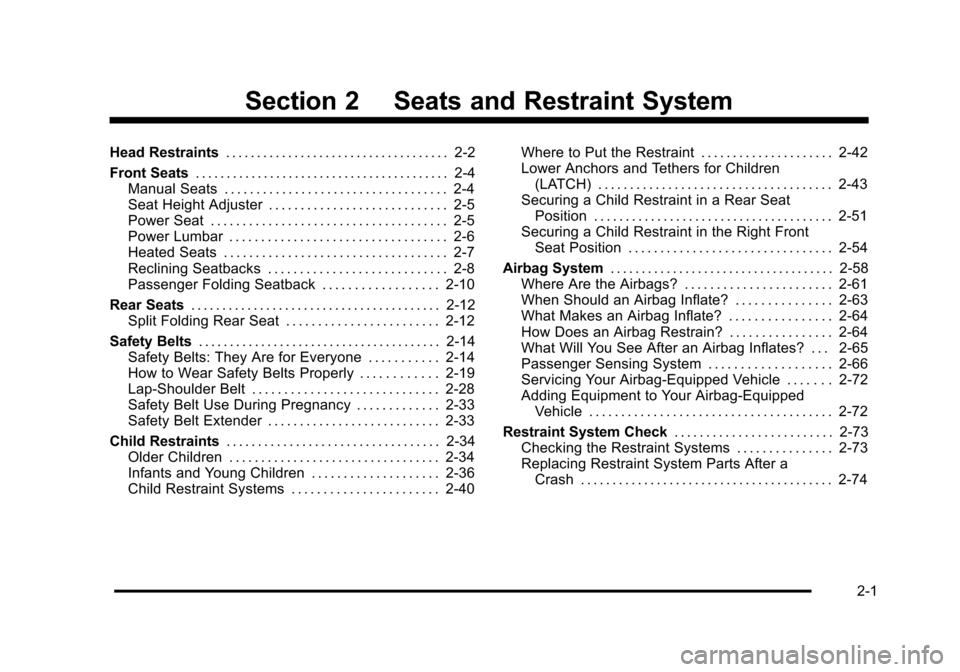
Black plate (1,1)Chevrolet HHR Owner Manual - 2011
Section 2 Seats and Restraint System
Head Restraints. . . . . . . . . . . . . . . . . . . . . . . . . . . . . . . . . . . . 2-2
Front Seats . . . . . . . . . . . . . . . . . . . . . . . . . . . . . . . . . . . . . . . . . 2-4
Manual Seats . . . . . . . . . . . . . . . . . . . . . . . . . . . . . . . . . . . 2-4
Seat Height Adjuster . . . . . . . . . . . . . . . . . . . . . . . . . . . . 2-5
Power Seat . . . . . . . . . . . . . . . . . . . . . . . . . . . . . . . . . . . . . 2-5
Power Lumbar . . . . . . . . . . . . . . . . . . . . . . . . . . . . . . . . . . 2-6
Heated Seats . . . . . . . . . . . . . . . . . . . . . . . . . . . . . . . . . . . 2-7
Reclining Seatbacks . . . . . . . . . . . . . . . . . . . . . . . . . . . . 2-8
Passenger Folding Seatback . . . . . . . . . . . . . . . . . . 2-10
Rear Seats . . . . . . . . . . . . . . . . . . . . . . . . . . . . . . . . . . . . . . . . 2-12
Split Folding Rear Seat . . . . . . . . . . . . . . . . . . . . . . . . 2-12
Safety Belts . . . . . . . . . . . . . . . . . . . . . . . . . . . . . . . . . . . . . . . 2-14
Safety Belts: They Are for Everyone . . . . . . . . . . . 2-14
How to Wear Safety Belts Properly . . . . . . . . . . . . 2-19
Lap-Shoulder Belt . . . . . . . . . . . . . . . . . . . . . . . . . . . . . 2-28
Safety Belt Use During Pregnancy . . . . . . . . . . . . . 2-33
Safety Belt Extender . . . . . . . . . . . . . . . . . . . . . . . . . . . 2-33
Child Restraints . . . . . . . . . . . . . . . . . . . . . . . . . . . . . . . . . . 2-34
Older Children . . . . . . . . . . . . . . . . . . . . . . . . . . . . . . . . . 2-34
Infants and Young Children . . . . . . . . . . . . . . . . . . . . 2-36
Child Restraint Systems . . . . . . . . . . . . . . . . . . . . . . . 2-40 Where to Put the Restraint . . . . . . . . . . . . . . . . . . . . . 2-42
Lower Anchors and Tethers for Children
(LATCH) . . . . . . . . . . . . . . . . . . . . . . . . . . . . . . . . . . . . . 2-43
Securing a Child Restraint in a Rear Seat Position . . . . . . . . . . . . . . . . . . . . . . . . . . . . . . . . . . . . . . 2-51
Securing a Child Restraint in the Right Front Seat Position . . . . . . . . . . . . . . . . . . . . . . . . . . . . . . . . 2-54
Airbag System . . . . . . . . . . . . . . . . . . . . . . . . . . . . . . . . . . . . 2-58
Where Are the Airbags? . . . . . . . . . . . . . . . . . . . . . . . 2-61
When Should an Airbag Inflate? . . . . . . . . . . . . . . . 2-63
What Makes an Airbag Inflate? . . . . . . . . . . . . . . . . 2-64
How Does an Airbag Restrain? . . . . . . . . . . . . . . . . 2-64
What Will You See After an Airbag Inflates? . . . 2-65
Passenger Sensing System . . . . . . . . . . . . . . . . . . . 2-66
Servicing Your Airbag-Equipped Vehicle . . . . . . . 2-72
Adding Equipment to Your Airbag-Equipped Vehicle . . . . . . . . . . . . . . . . . . . . . . . . . . . . . . . . . . . . . . 2-72
Restraint System Check . . . . . . . . . . . . . . . . . . . . . . . . .2-73
Checking the Restraint Systems . . . . . . . . . . . . . . . 2-73
Replacing Restraint System Parts After a Crash . . . . . . . . . . . . . . . . . . . . . . . . . . . . . . . . . . . . . . . . 2-74
2-1
Page 42 of 430
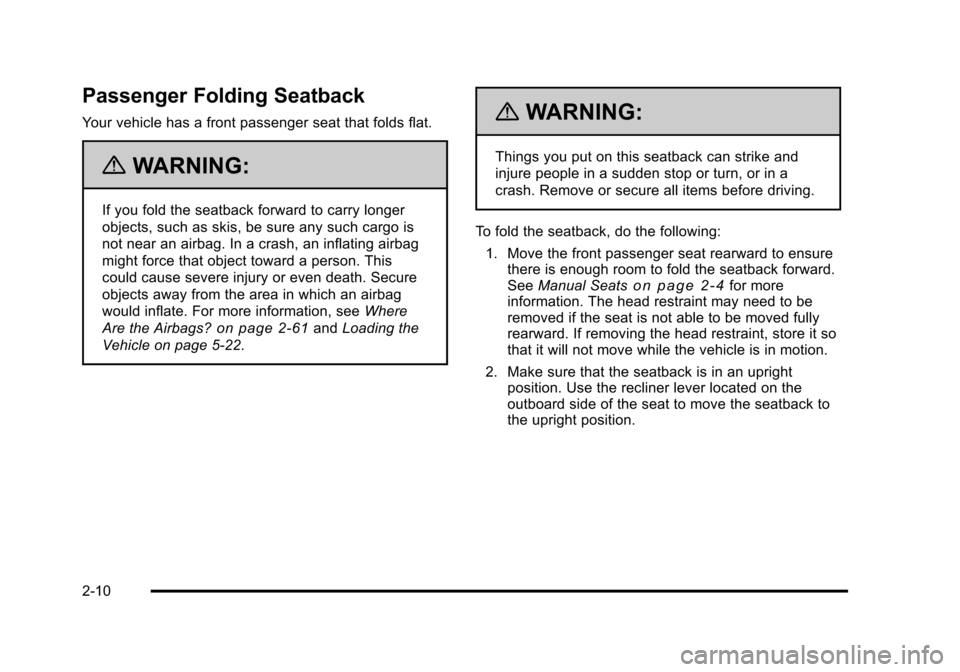
Black plate (10,1)Chevrolet HHR Owner Manual - 2011
Passenger Folding Seatback
Your vehicle has a front passenger seat that folds flat.
{WARNING:
If you fold the seatback forward to carry longer
objects, such as skis, be sure any such cargo is
not near an airbag. In a crash, an inflating airbag
might force that object toward a person. This
could cause severe injury or even death. Secure
objects away from the area in which an airbag
would inflate. For more information, seeWhere
Are the Airbags?
on page 2‑61and Loading the
Vehicle on page 5‑22.
{WARNING:
Things you put on this seatback can strike and
injure people in a sudden stop or turn, or in a
crash. Remove or secure all items before driving.
To fold the seatback, do the following: 1. Move the front passenger seat rearward to ensure there is enough room to fold the seatback forward.
See Manual Seats
on page 2‑4for more
information. The head restraint may need to be
removed if the seat is not able to be moved fully
rearward. If removing the head restraint, store it so
that it will not move while the vehicle is in motion.
2. Make sure that the seatback is in an upright position. Use the recliner lever located on the
outboard side of the seat to move the seatback to
the upright position.
2-10
Page 60 of 430
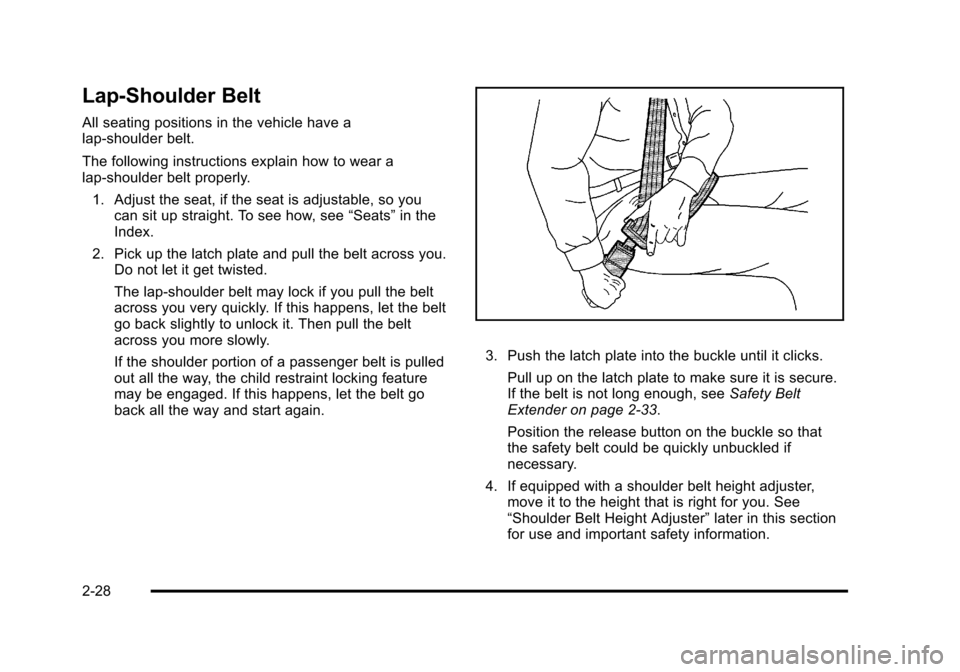
Black plate (28,1)Chevrolet HHR Owner Manual - 2011
Lap-Shoulder Belt
All seating positions in the vehicle have a
lap-shoulder belt.
The following instructions explain how to wear a
lap-shoulder belt properly.1. Adjust the seat, if the seat is adjustable, so you can sit up straight. To see how, see “Seats”in the
Index.
2. Pick up the latch plate and pull the belt across you. Do not let it get twisted.
The lap-shoulder belt may lock if you pull the belt
across you very quickly. If this happens, let the belt
go back slightly to unlock it. Then pull the belt
across you more slowly.
If the shoulder portion of a passenger belt is pulled
out all the way, the child restraint locking feature
may be engaged. If this happens, let the belt go
back all the way and start again.
3. Push the latch plate into the buckle until it clicks.
Pull up on the latch plate to make sure it is secure.
If the belt is not long enough, see Safety Belt
Extender on page 2‑33.
Position the release button on the buckle so that
the safety belt could be quickly unbuckled if
necessary.
4. If equipped with a shoulder belt height adjuster, move it to the height that is right for you. See
“Shoulder Belt Height Adjuster” later in this section
for use and important safety information.
2-28
Page 65 of 430
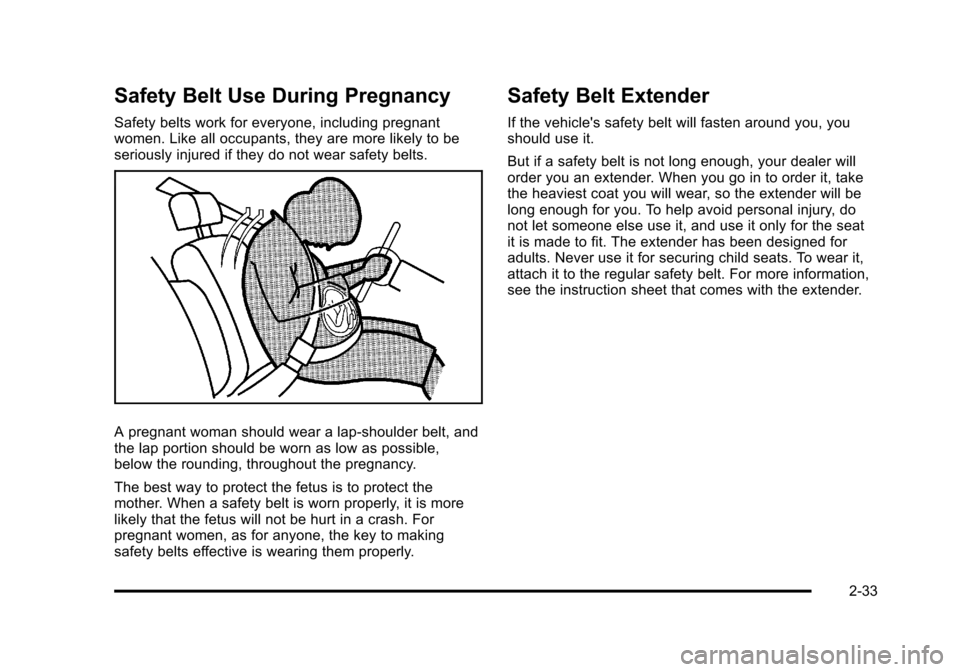
Black plate (33,1)Chevrolet HHR Owner Manual - 2011
Safety Belt Use During Pregnancy
Safety belts work for everyone, including pregnant
women. Like all occupants, they are more likely to be
seriously injured if they do not wear safety belts.
A pregnant woman should wear a lap-shoulder belt, and
the lap portion should be worn as low as possible,
below the rounding, throughout the pregnancy.
The best way to protect the fetus is to protect the
mother. When a safety belt is worn properly, it is more
likely that the fetus will not be hurt in a crash. For
pregnant women, as for anyone, the key to making
safety belts effective is wearing them properly.
Safety Belt Extender
If the vehicle's safety belt will fasten around you, you
should use it.
But if a safety belt is not long enough, your dealer will
order you an extender. When you go in to order it, take
the heaviest coat you will wear, so the extender will be
long enough for you. To help avoid personal injury, do
not let someone else use it, and use it only for the seat
it is made to fit. The extender has been designed for
adults. Never use it for securing child seats. To wear it,
attach it to the regular safety belt. For more information,
see the instruction sheet that comes with the extender.
2-33
Page 67 of 430
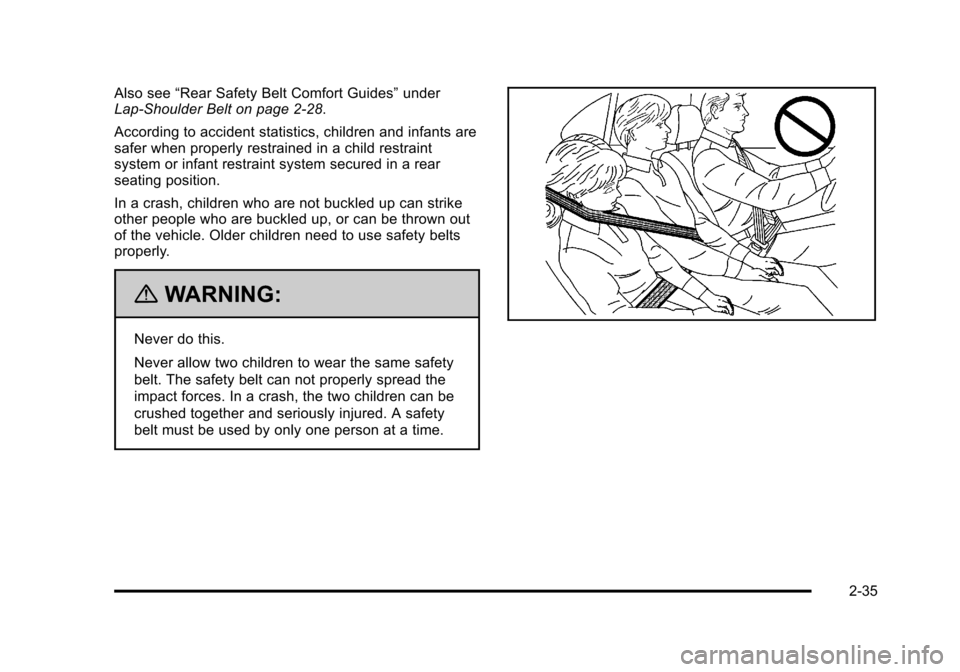
Black plate (35,1)Chevrolet HHR Owner Manual - 2011
Also see“Rear Safety Belt Comfort Guides” under
Lap-Shoulder Belt on page 2‑28.
According to accident statistics, children and infants are
safer when properly restrained in a child restraint
system or infant restraint system secured in a rear
seating position.
In a crash, children who are not buckled up can strike
other people who are buckled up, or can be thrown out
of the vehicle. Older children need to use safety belts
properly.
{WARNING:
Never do this.
Never allow two children to wear the same safety
belt. The safety belt can not properly spread the
impact forces. In a crash, the two children can be
crushed together and seriously injured. A safety
belt must be used by only one person at a time.
2-35
Page 69 of 430
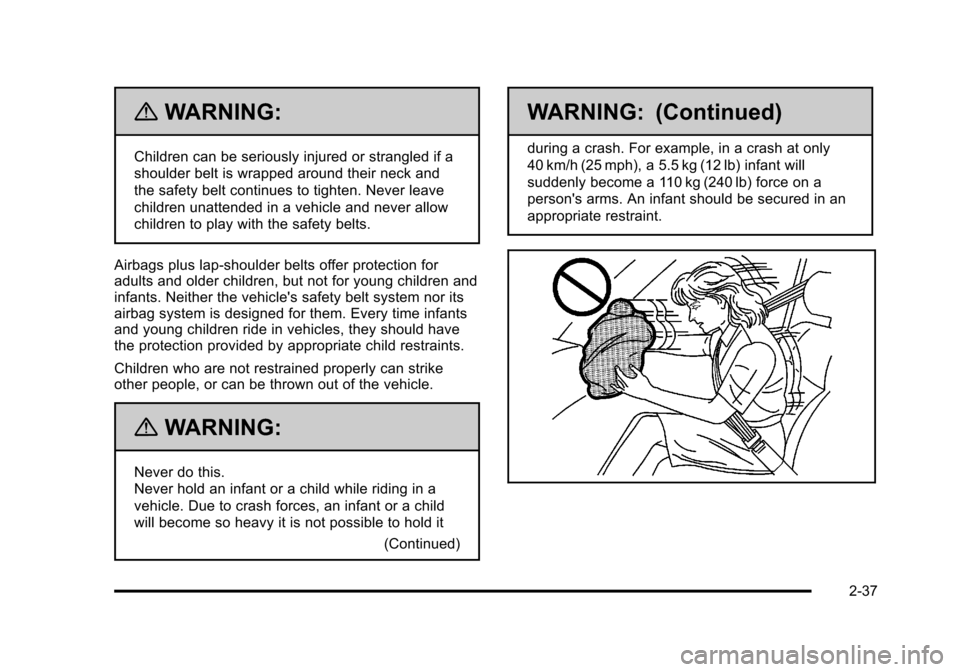
Black plate (37,1)Chevrolet HHR Owner Manual - 2011
{WARNING:
Children can be seriously injured or strangled if a
shoulder belt is wrapped around their neck and
the safety belt continues to tighten. Never leave
children unattended in a vehicle and never allow
children to play with the safety belts.
Airbags plus lap‐shoulder belts offer protection for
adults and older children, but not for young children and
infants. Neither the vehicle's safety belt system nor its
airbag system is designed for them. Every time infants
and young children ride in vehicles, they should have
the protection provided by appropriate child restraints.
Children who are not restrained properly can strike
other people, or can be thrown out of the vehicle.
{WARNING:
Never do this.
Never hold an infant or a child while riding in a
vehicle. Due to crash forces, an infant or a child
will become so heavy it is not possible to hold it (Continued)
WARNING: (Continued)
during a crash. For example, in a crash at only
40 km/h (25 mph), a 5.5 kg (12 lb) infant will
suddenly become a 110 kg (240 lb) force on a
person's arms. An infant should be secured in an
appropriate restraint.
2-37
Page 70 of 430
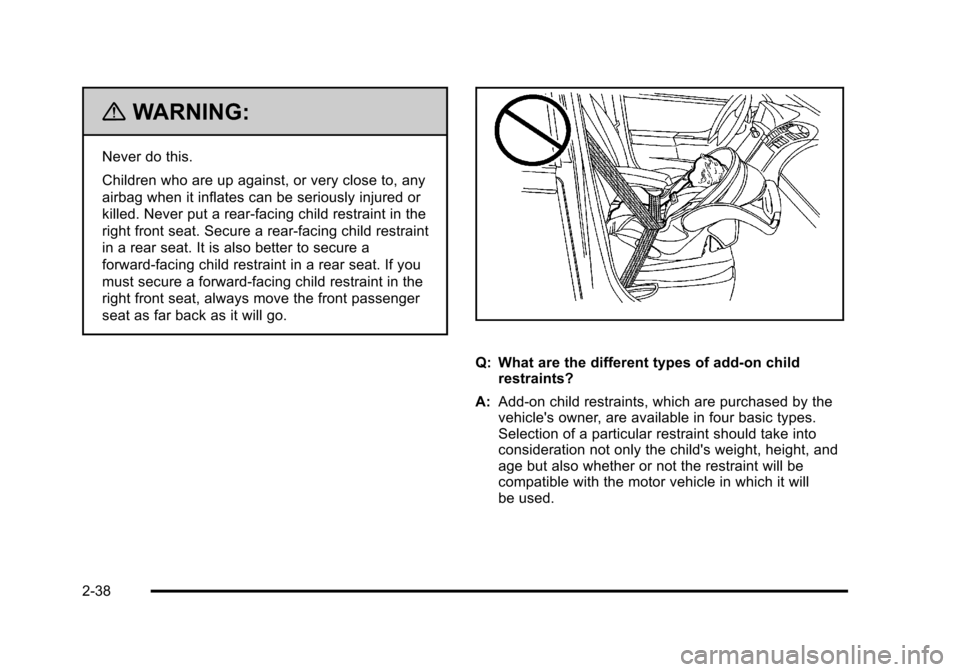
Black plate (38,1)Chevrolet HHR Owner Manual - 2011
{WARNING:
Never do this.
Children who are up against, or very close to, any
airbag when it inflates can be seriously injured or
killed. Never put a rear-facing child restraint in the
right front seat. Secure a rear-facing child restraint
in a rear seat. It is also better to secure a
forward-facing child restraint in a rear seat. If you
must secure a forward-facing child restraint in the
right front seat, always move the front passenger
seat as far back as it will go.
Q: What are the different types of add-on childrestraints?
A: Add-on child restraints, which are purchased by the
vehicle's owner, are available in four basic types.
Selection of a particular restraint should take into
consideration not only the child's weight, height, and
age but also whether or not the restraint will be
compatible with the motor vehicle in which it will
be used.
2-38